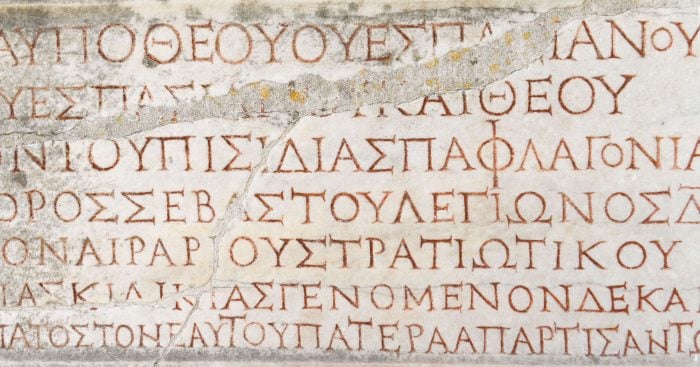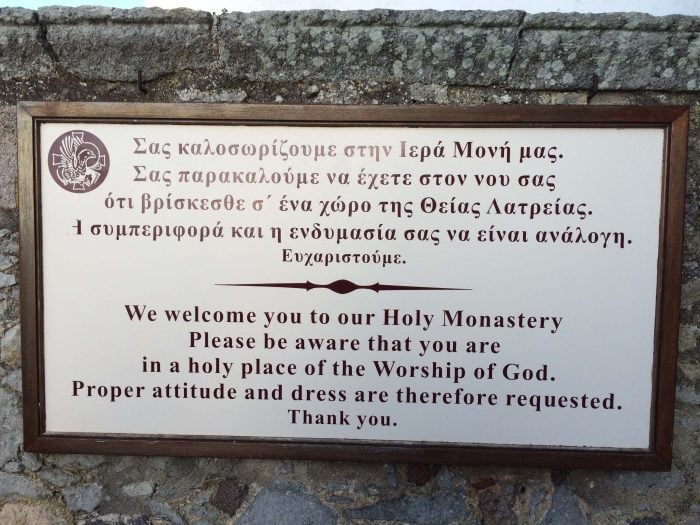Everything You Need to Know About the Greek Alphabet
Greek is one of the most beautiful languages in the world. However, we can’t lie to our readers. The Greek alphabet, which is based on the Phoenician writing system, can give you a bit of a headache if you don’t learn it thoroughly before attempting to use the language for communication.
Would you like enjoy Greek podcasts while you commute to work? Well, you have to start somewhere. Below, you will find detailed information on the 24 Greek alphabet symbols and you will learn how to pronounce them. That way, when you get to reading or writing the alphabet in Greek it’s going to be much easier and far less frustrating!

Photo by Francisco Anzola via Flickr
Άλφα – A
English Name: Alpha
First in our list is the famous Alpha. A is the first letter of the Greek alphabet, and it derives from an ancient Egyptian symbol for the head of a horned ox. As with most Greek letters, Alpha has a near English equivalent in words such as cat o man.
Βήτα – B
English name: Beta
Second, let us introduce you to B (romanisation). This letter, which is a representation of a two-story, has the same ancestors as “Beth”, Hebrew for “home”. Its English counterpart is ”v”, the sounds we have in words like vase or vet.
Γάμα – Γ
English name: Gamma
Alpha is not the only Greek letter that comes from the animal world. The word Gamma (romanization: G), like the word gimel in Semitic, means camel, as the letter is looks like a camel’s head. The sound of this letter is like that of “y” in yes or yacht.
Δέλτα – Δ
English name: Delta
Originally, “Delta” used to represent a door. In Greek, the mouth of a river and other triangular shapes are known as “deltas”. For modern speakers, this letter is pronounced as a voiced dental fricative consonant, like the [th] in this or although.
Έψιλον – E
English name: Epsilon
As a sound, this letter is as transparent as its English equivalent: “e”. It’s the sounds we produce to say words like egg or met.
Ζήτα – Z
English name: Zeta
Although Greek is an ancient language itself, much of the Greek alphabet comes from even older languages. The letter “zeta”, for example, comes from the Semitic alphabet. It’s the sound that we use in English to say things like zoo and zoom.
Ήτα – H
English name: Eta
Next in line is H. Originally denoting the consonant “h” as in hot, its sound value has shifted through time to denote the sound produced by the doubling of letter e, as in bee and meet. However, this Greek alphabet letter is still romanised as H.
Θήτα – Θ
English name: Theta
The symbol for theta actually used to exist in Old English, but the symbol “th” had replaced by Norman times. It represents the tip of the tongue placed between the front teeth in the open mouth, as when an English speaker says thin or think. In fact, the symbol is still used in the International Phonetic Alphabet to represent this consonant sound.
Γιώτα – Ι
English name: Yota
Yota represents the “i” vowel. The English equivalents would be the short vowel sound as in sit, and the first element in the diphthong /ɪə/, as in beer.
Κάππα – Κ
English name: Kappa
Kappa is one of the most transparent consonants in the Greek alphabet. It was adopted directly from the Semitic languages without any changes and also passed into Latin and English to represent the “k” sound.
Λάμδα – Λ
English name: Lamda
The letter “λ”, which has the shape of an angle, comes directly from the Semitic alphabet. but its orientation varied. While the Greeks use the letter with the angle pointing upwards, the Romans turned it on its side to become the Latin “L”. Thus, this is the sound we use in English in words like love and lost.
Μι – M
English name: Mi
This letter resembles a horned owl, and it’s one of the few symbols still present in the Greek alphabet that went into Latin and English unchanged. The equivalent in English is the consonant in mom and meme.
Νι – N
English name: Ni
Another symbolic letter, N is supposed to be the representation of waves of water. This is yet another symbol that passed from Semitic into Greek, then to Latin, and finally to modern languages such as English. We use this sound in words like night and not.
Ξι – Ξ
English name: Ksi
The origins of Ξ, Ksi, or X in its romanised version are somewhat unknown. For some reason, the Greeks decided to use three bars for the “ks” double consonant, i.e., the sound that we represent with an X in words like box and fox.
Όμικρον – Ο
English name: Omikron
To produce this sound, the throat and the lips stay in a rounded position, hence its circular shape. Micro literally means little, so this sound is called something like “little o”. Indeed, it’s the equivalent to what we call a “short o” in English, the sound we find in British English in words like clock or mock.
Πι – Π
English name: Pi
The Semitic form of this letter has no specific meaning. The Greek letter is used for the shape of a circle with a unit diameter. How this symbol became the Roman “P”, matching the Greek letter for the /r/ sound, is still unknown, but it’s the sound English speakers use when they say pop and peep.
Ρο – P
English name: Rho
This Greek letter has its origins in the Semitic alphabet. To distinguish it from their altered version of Pi, which they adopted for the /p/ consonant, the Romans decided to add a diagonal bar to it, giving present-day English R, the sound we use in words such as river and rent.
Σίγμα – Σ
English name: Sigma
Sigma is yet another borrowing from the Semitic alphabet, where it once had the shape of Latin “W”. Eventually, it was turned on its side to make the classical Greek Σ. The English equivalent, [s], is the consonant we have in song and Sam.
Ταυ – T
English name: Taf
Because both Greek and Latin “T” resembles a cross, some of the early Christian scribes thought this symbol had a religious meaning. Although this is only speculative, the cross-like shape has passed unchanged to languages such as English, in which we use “t” in words such as teach and talk.
Φι – Phi
English name: Phi
The Ancient Greeks had a special letter (digamma) for the “f” sound but eventually stopped using it. The Romans revived it, and as a result, languages deriving from Latin did not need a special letter for “ph”. In English, the Greek origin of a lexical item is indicated by the use of the “ph” letter-pair, as in photo and pharmacy.
Χι – Χ
English name: Khi
The alphaber in Greek was the first to use this symbol. Its deep-throated sound is non-existent in English, although it’s very common in Spanish in words such as jamón (ham) and jarrón (jar). In English, you can only find it in some regional dialects, like in the word “loch” in Scottish English.
Ψι – Ψ
English name: Psi
For reasons unknown, the Greeks invented a separate symbol for the “ps” sound, which is very common in words of Greek origin. In English, “p” is silent at the beginning of a word when followed by “s” (“psychology”, “psalm”), but in Greek it is.
Ωμέγα – Ω
English name: Omega
This is the 24th and the last letter in the Greek alphabet. In Ancient Greek, it stood for a long “o” vowel sound, but in Modern Greek, this distinction between long and short “o” has been lost so it sounds the same as Omicron.

Photo by John Karakatsanis via Flickr
Before we reach the end of today’s blog, it’s time for a great exercise to practice Greek symbols: writing your own name using the Greek alphabet!
Some common Australian names are written like this using the Greek alphabet:
- Michael (Μάικλ)
- Daniel (Ντάνιελ)
- George (Τζορτζ)
- Thomas (Τόμας)
- Hunter (Χάντερ)
- Elizabeth (Ελίζαμπεθ)
- Henry (Χένρι)
- Heather (Χέδερ)
Mine (Juan) would be Χουαν. What would your name look like if you used the alphabet in Greek? Let us know in the comments!
So, that’s it. Those are the 24 letters of the Greek alphabet. Now that you are familiar with them, you are ready to start learning some Greek!
Customised Greek Courses: Go Beyond the Greek Alphabet!
At Language Trainers, we are firm believers that the most effective way to achieve language proficiency is through personalized, tailor-made courses guided by native tutors. With this philosophy in mind, we have curated a team of highly qualified Greek teachers whose main goal is to provide exceptional language learning experiences.
Whther you want to learn Greek in Sydney or you’re looking for Greek teachers in Melbourne, our commitment is to ensure that each student receives a customized lesson plan that precisely caters to their unique requirements and goals.
So, what are you waiting for to go beyond the alphabet in Greek! Take the first step towards mastering Greek by sending us a quick enquiry, and rest assured that we will promptly respond to your request. Your language journey awaits!
Send us a quick enquiry and we’ll get back to you in no time!
This article was updated on 29 June, 2023.
